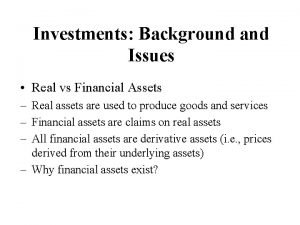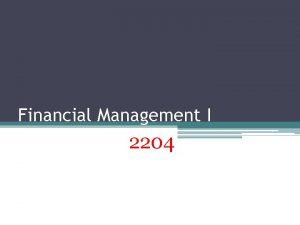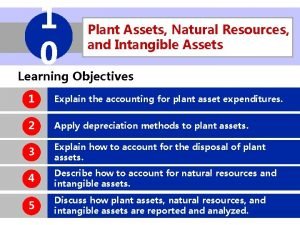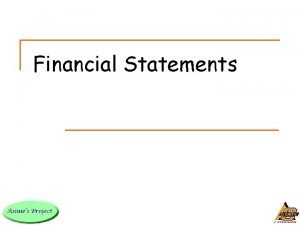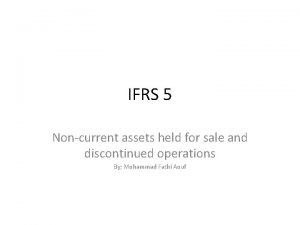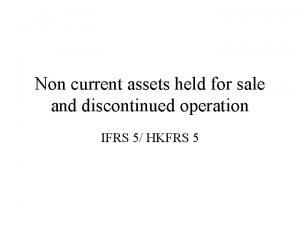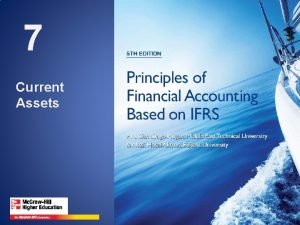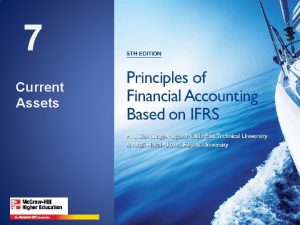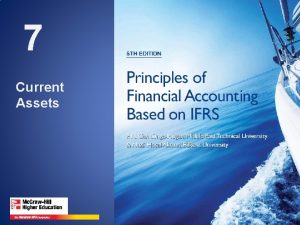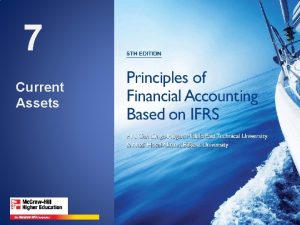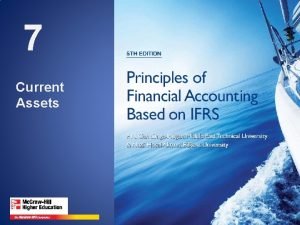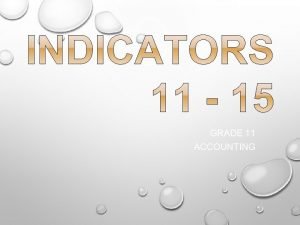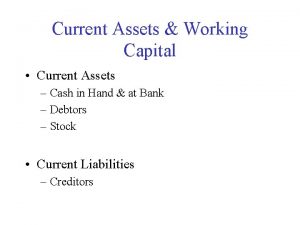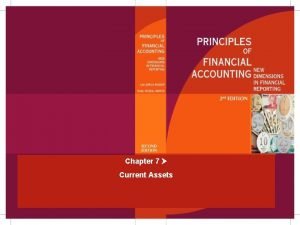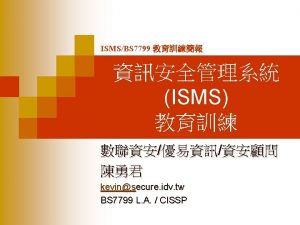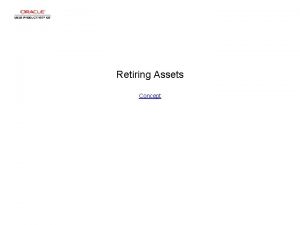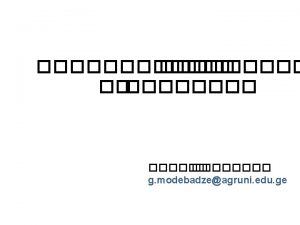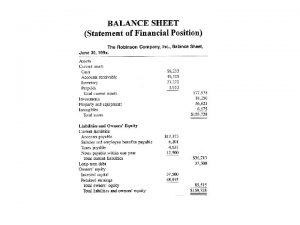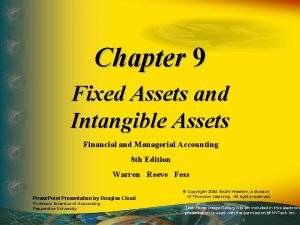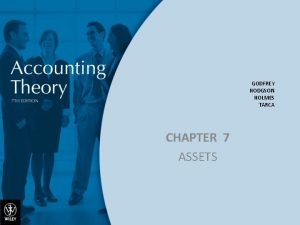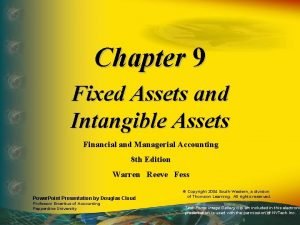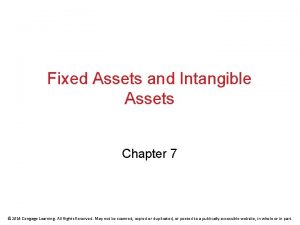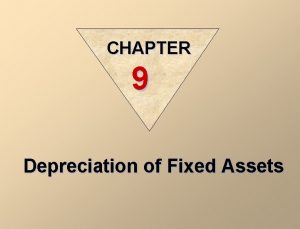CHAPTER 7 Current assets n assets that are
































- Slides: 32

CHAPTER 7

Current assets n assets that are expected to be converted into cash within one year or within the operating cycle of an entity Chapter 7 Mugan-Akman 2010 2

Current Asset Section of a Statement of Financial Position Chapter 7 Mugan-Akman 2010 3

Economic Consequences of Accounting n on wealth or behavior of ¡ ¡ ¡ n lenders and investors reporting entities, their management and users of financial statements reporting entities and standard setters Sources of impact ¡ ¡ Chapter 7 Effect of financial results reported in the financial statements Effect of firm’s choice of accounting principles Effect on reporting entities of standard setters’ decisions Effect on standard setters of their decisions Mugan-Akman 2010 4

Quality of Earnings n n Business: having stable and recurring basic revenue generating activities Accounting: 1) using consistent estimates and rules High: same methods of estimation and rules n 2) proximity of revenue recognition and cash collection ¡ High: when revenue recognition and cash collection are close High quality earnings are presumed to be fair representations of the economic performance of the firm Low quality earnings overstate fair earnings Chapter 7 Mugan-Akman 2010 5

What will affect Quality of Earnings? n Managers’ discretion in measuring and reporting earnings in: ¡ ¡ ¡ Chapter 7 Choosing among alternative accounting principles Making estimates Timing transactions in order to control recognition Mugan-Akman 2010 6

Why is Current Asset Management Important? n n n solvency profitability profitable but insolvent quality of receivables credit policies idle cash Chapter 7 Mugan-Akman 2010 7

Cash and Cash Equivalents n Cash ¡ ¡ ¡ n Coins, banknotes deposits at banks, checks received from customers Restricted Cash or Blocked Cash and the related amounts should not be included in the cash amount Petty Cash Equivalents ¡ Chapter 7 Investments that are readily convertible to cash with insignificant risk and with a maturity less than 90 days- e. g. Treasury Bills, term-deposits with less than 90 days maturity Mugan-Akman 2010 8

Checks Received From Customers n n n by law, checks are payable at sight, so they are deemed as liquid and should be included as cash in the statements of financial position of the entities although the concept of post dated checks is not within the context of the legislation, in practice checks with future payment dates are issued in Turkey due-dated checks should not be included as cash but treated as notes receivable in the statement of financial position. Chapter 7 Mugan-Akman 2010 9

Control Over Cash n n n n easily transportable large number of transactions involving cash Establish Responsibilities Segregation of Duties Documentation Controls Physical Controls Independent Internal Verification Use of Bank Accounts Chapter 7 Mugan-Akman 2010 10

Receivables n n n Accounts Receivable Notes Receivable Other Receivables Chapter 7 Mugan-Akman 2010 11

Recognition of Accounts Receivable n n accrual basis of accounting- sales revenue is recognized at the time a sale is made and the title of ownership of the items under the sale passes to the buyer regardless of the cash payment date when sales are made on credit the accounts receivable is recognized and recorded at the invoice amount when a sale is realized Chapter 7 Mugan-Akman 2010 12

Valuation of Receivables-IFRS n n n a risk that a customer will not pay or will not be able to pay its debt IFRS -accounts receivable should be valued at their net realizable value (or net recoverable amount) Net Realizable Value represents the amount of cash expected to be collected from the receivables net recoverable amount of accounts receivable (or trade receivables) is equal to their original values unless there is an indication of impairment Entities should assess at each statement of financial position date whethere is objective evidence that an account receivable may be impaired, and determine the amount of allowance that should be estimated based on the net realizable value or the discounted cash flow from such receivable TAX- when it is certain that a customer is not going to pay write-off the account *i. e. erase from the accounts and record it as a loss Chapter 7 Mugan-Akman 2010 13

Impairment of Accounts Receivable. IFRS n n Matching principle and losses estimated from selling on credit Some possible indications of impairment are as follows: ¡ ¡ ¡ n If there is a sign that the customer has financial difficulty, If there is a high probability of bankruptcy of the customer, If the customer delays its payments, If the customer asks for extension of the payment period, and If the economy in general or the industry the customer operates in suffers from financial difficulties under IAS 39, general provisions are not permitted and all impairment of trade receivables must be measured using a discounted cash flow methodology Chapter 7 Mugan-Akman 2010 14

Impairment Loss n n n measured as the difference between the original or the carrying value of the receivable and the present value of estimated cash flows discounted at the original effective interest rate of the receivable effective interest rate is the rate that exactly discounts estimated future cash receipts through the expected collection date of the receivable to the net carrying amount of the receivable Allowance for Uncollectible Accounts account ¡ ¡ ¡ Chapter 7 accumulates the estimated losses contra-asset account deducted from Accounts Receivable in order to determine the net realizable value of receivables replenished every period decreases by the realization of loss due to customer default through the write off process Mugan-Akman 2010 15

Adjusting Entry-IFRS Dekorasyon A. Ş. has outstanding receivables of TL 120. 000 as of 31 December 2011, and its management estimated that there is impairment of TL 10. 000 Chapter 7 Mugan-Akman 2010 16

Determining the Impairment Loss n n examine each receivable or customer carefully and assess whethere is an indication of impairment prepare a chart showing all trade receivables and whethere is an indication of impairment Chapter 7 Mugan-Akman 2010 17

Illustration of Impairment-IFRS Sağlam Yapı Market is in the process of preparing the financial statements for the year 2012. The credit department examined all outstanding receivables and determined that the following accounts may be impaired as of 31 December 2012. Total accounts receivable as of 31 December 2012 is TL 59. 750 Difference= impairment loss of TL 4. 183 Chapter 7 Mugan-Akman 2010 18

How much is the expense? n n difference between total of net recoverable amount of accounts receivable and the total invoice amount represents the targeted balance for the Allowance for Uncollectible Accounts adjusting entry to record the impairment loss on accounts receivable should bring the balance of the Allowance for Uncollectible Accounts to the amount estimated from the impairment of accounts receivable Chapter 7 Mugan-Akman 2010 19

Adjusting Entries – target impairment loss known- Case 1 Allowance for Uncollectible Account Balance is a credit of TL 2. 950 Estimated (target) Allowance for Uncollectible Accounts Balance of Allowance for Uncollectible Accounts Before Adjustment Estimated Impairment Loss TL 4. 183 CR 2. 950 CR TL 1. 233 Statement of Financial Position Representation Accounts Receivable TL 59. 750 Allowance for Uncollectible Accounts 4. 183 Net Realizable Value of Accounts Receivable TL 55. 567 Chapter 7 Mugan-Akman 2010 20

Adjusting Entries – target impairment loss known- Case 2 Allowance for Uncollectible Account Balance is credit of TL 6. 283 Balance of Allowance for Uncollectible Account Before Adjustment TL 6. 283 CR Estimated Allowance for Uncollectible Accounts 4. 183 CR Recovery of Impairment Loss TL 2. 100 Statement of Financial Position Representation Accounts Receivable TL 59. 750 Allowance for Uncollectible Accounts 4. 183 Net Realizable Value of Accounts Receivable TL 55. 567 Chapter 7 Mugan-Akman 2010 21

Write Off of Accounts Receivable n a specific customer is not able to pay its debt Risk A. Ş. declared bankruptcy on 20 March 2013 Chapter 7 Mugan-Akman 2010 22

Recovery of Receivables Written Off Risk A. Ş. informed Sağlam Yapı Market that it will pay TL 3. 000 of its total debt on 3 April 2013 and the remaining amount later Chapter 7 Mugan-Akman 2010 23

Financing with Accounts Receivable n n n Pledge of Accounts Receivable - used as a guarantee in credit arrangements with financial institutions to receive loans-IFRS requires that pledge agreements should be disclosed in the notes to the financial statements Factoring Accounts Receivable- selling receivables to get cash before the maturity (due date) of the receivables Credit Card Sales Chapter 7 Mugan-Akman 2010 24

Factoring Accounts Receivable n n With recourse - factor can collect the receivable from the seller if the customer does not pay the receivable – risk with lies with the company Without recourse -risk of non-payment of the customer lies with the factor Based on the risks involved rates differ In the case of with recourse factoring the entity may become liable to the factor - this contingent liability should be disclosed in the notes to the financial statements Chapter 7 Mugan-Akman 2010 25

Credit Card Sales Gourmet Restaurant served dinner to various customers on 11 May 2011 and collected TL 750 with the credit cards. Gourmet Restaurant’s agreement with INVO Bank to collect the credit card slips is 21 days with 5% interest rate Chapter 7 Mugan-Akman 2010 26

Other Current Assets • Value Added Taxes Deductible and Carried Forward • Advances Given • Prepaid Taxes • Prepaid Expenses Chapter 7 Mugan-Akman 2010 27

Common Financial Ratios Used in Management of Current Assets Chapter 7 Mugan-Akman 2010 28

APPENDIX 7 Chapter 7 Mugan-Akman 2010 29

Accounting for Uncollectible Accounts -FASB Uncollectible Accounts Allowance Methods Direct Write-off Method Percentage of Sales Chapter 7 Mugan-Akman 2010 Aging of Accounts Receivable 30

Direct Write-off Dekorasyon A. Ş. sold furniture at TL 1. 000 to Mr. Aksoy in December 2011 with terms n/60. However, Mr. Aksoy was in financial difficulty and informed Dekorasyon A. Ş. that he bankrupted in May 2012. Since it became evident that this receivable cannot be collected, Dekorasyon A. Ş. decided to write off the receivable. Chapter 7 Mugan-Akman 2010 31

Chapter 7 Mugan-Akman 2010 32
 Antigentest åre
Antigentest åre Phân độ lown
Phân độ lown Block xoang nhĩ
Block xoang nhĩ Thơ thất ngôn tứ tuyệt đường luật
Thơ thất ngôn tứ tuyệt đường luật Thơ thất ngôn tứ tuyệt đường luật
Thơ thất ngôn tứ tuyệt đường luật Chiến lược kinh doanh quốc tế của walmart
Chiến lược kinh doanh quốc tế của walmart Tìm độ lớn thật của tam giác abc
Tìm độ lớn thật của tam giác abc Con hãy đưa tay khi thấy người vấp ngã
Con hãy đưa tay khi thấy người vấp ngã Tôn thất thuyết là ai
Tôn thất thuyết là ai Gây tê cơ vuông thắt lưng
Gây tê cơ vuông thắt lưng Sau thất bại ở hồ điển triệt
Sau thất bại ở hồ điển triệt Real and financial assets
Real and financial assets Real assets vs financial assets
Real assets vs financial assets Types of real assets
Types of real assets The three plant asset disposal methods
The three plant asset disposal methods Accumulated depreciation straight line method
Accumulated depreciation straight line method Real assets versus financial assets
Real assets versus financial assets Plant assets, natural resources, and intangible assets
Plant assets, natural resources, and intangible assets Examples of non current assets
Examples of non current assets Current assets examples
Current assets examples Management of current assets
Management of current assets Scope of ifrs 5
Scope of ifrs 5 Financing current assets
Financing current assets Current assests
Current assests Conclusion of financial management
Conclusion of financial management Line current and phase current
Line current and phase current Power formula three phase
Power formula three phase Drift current and diffusion current
Drift current and diffusion current Ac theory 3 lesson 4
Ac theory 3 lesson 4 Drift current and diffusion current
Drift current and diffusion current Intrinsic semiconductor
Intrinsic semiconductor The constant current region of a jfet lies between
The constant current region of a jfet lies between In a triangle connected source feeding a y connected load
In a triangle connected source feeding a y connected load











